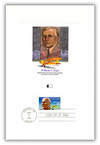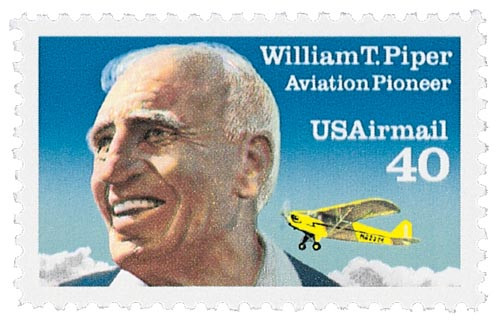
# 55885 FDC - 1991 40c William Piper Proofcard
Often called the ultimate philatelic issue, the Fleetwood Proofcard is a distinctive commemorative with an elegantly embossed surface. Each Proofcard bears an original work of art complementing the theme of the stamp and created exclusively for Fleetwood by a leading American artist. Proofcards are often collected on their own, but would also make a beautiful addition to your existing stamp or cover collection.
William T. Piper
William Thomas Piper was born on January 8, 1881, in Knapp Creek, New York.
From a young age, Piper worked on his family’s dairy farm. At the age of nine, he began helping his father’s oil business, repairing well pumps. Over time his father made enough money to move the family to Bradford, Pennsylvania.
Following the sinking of the USS Maine in 1898, Piper lied about his age so that he could join the US Army and fight in the Spanish-American War. After the war he attended Harvard University. Piper graduated in 1903 with honors, earning degrees in business and mechanical engineering. During World War I, he reached the rank of captain in the Corps of Engineers.
Piper then went on to earn his fortune in oil wells. Though he’s known for his contributions to aviation today, his entrance into the industry wasn’t planned. While working at an oil business in Bradford, Pennsylvania, Piper’s partner (without Piper’s knowledge) pledged $400 toward an airplane manufacturing facility. When the Taylor Brothers Aircraft Corporation was established, Piper was elected to the board. The Great Depression caused the company to go bankrupt. Piper was the only person to bid on it during the public sale. He bought the company for $761.
Soon after, Piper designed and built the Cub, a reliable, inexpensive aircraft. It cost $1,325 (about $51,200 in today’s wages) and included free flying lessons. Cubs became so popular, Piper became known as the “Henry Ford of Aviation.” In spite of the country’s economic hardship, the company grew, and Piper converted an old silk mill in Lock Haven, Pennsylvania, into the new factory for Piper Aircraft Corporation.
As World War II approached, President Roosevelt began a pilot training program using Cubs. During Army war games, the planes proved their worth by directing artillery fire and infantry. During this time, the planes were given the nickname “Grasshopper.” When the US entered the war, Piper’s planes joined the fight. In addition to directing firepower, Grasshoppers flew reconnaissance missions, some were modified as ambulance planes, and some were armed with bazookas to take out tanks or enemy artillery. By the time the war ended, four out of five American pilots had been trained on Piper Cubs. And the Piper Cub was the most-produced fabric-covered monoplane in history, with more than 20,000 built between 1938 and 1947.
After the war, Piper expanded his inventory to include bigger planes. Piper continued to direct the company until he was 87 years old. During his career of almost four decades, Piper established the role of private airplanes in America as well as helping change the course of World War II.
Piper died at home on January 15, 1970. Piper was posthumously inducted into the National Aviation Hall of Fame and the International Air and Space Hall of Fame. An airport in Lock Haven, Pennsylvania was also named in his honor.
Often called the ultimate philatelic issue, the Fleetwood Proofcard is a distinctive commemorative with an elegantly embossed surface. Each Proofcard bears an original work of art complementing the theme of the stamp and created exclusively for Fleetwood by a leading American artist. Proofcards are often collected on their own, but would also make a beautiful addition to your existing stamp or cover collection.
William T. Piper
William Thomas Piper was born on January 8, 1881, in Knapp Creek, New York.
From a young age, Piper worked on his family’s dairy farm. At the age of nine, he began helping his father’s oil business, repairing well pumps. Over time his father made enough money to move the family to Bradford, Pennsylvania.
Following the sinking of the USS Maine in 1898, Piper lied about his age so that he could join the US Army and fight in the Spanish-American War. After the war he attended Harvard University. Piper graduated in 1903 with honors, earning degrees in business and mechanical engineering. During World War I, he reached the rank of captain in the Corps of Engineers.
Piper then went on to earn his fortune in oil wells. Though he’s known for his contributions to aviation today, his entrance into the industry wasn’t planned. While working at an oil business in Bradford, Pennsylvania, Piper’s partner (without Piper’s knowledge) pledged $400 toward an airplane manufacturing facility. When the Taylor Brothers Aircraft Corporation was established, Piper was elected to the board. The Great Depression caused the company to go bankrupt. Piper was the only person to bid on it during the public sale. He bought the company for $761.
Soon after, Piper designed and built the Cub, a reliable, inexpensive aircraft. It cost $1,325 (about $51,200 in today’s wages) and included free flying lessons. Cubs became so popular, Piper became known as the “Henry Ford of Aviation.” In spite of the country’s economic hardship, the company grew, and Piper converted an old silk mill in Lock Haven, Pennsylvania, into the new factory for Piper Aircraft Corporation.
As World War II approached, President Roosevelt began a pilot training program using Cubs. During Army war games, the planes proved their worth by directing artillery fire and infantry. During this time, the planes were given the nickname “Grasshopper.” When the US entered the war, Piper’s planes joined the fight. In addition to directing firepower, Grasshoppers flew reconnaissance missions, some were modified as ambulance planes, and some were armed with bazookas to take out tanks or enemy artillery. By the time the war ended, four out of five American pilots had been trained on Piper Cubs. And the Piper Cub was the most-produced fabric-covered monoplane in history, with more than 20,000 built between 1938 and 1947.
After the war, Piper expanded his inventory to include bigger planes. Piper continued to direct the company until he was 87 years old. During his career of almost four decades, Piper established the role of private airplanes in America as well as helping change the course of World War II.
Piper died at home on January 15, 1970. Piper was posthumously inducted into the National Aviation Hall of Fame and the International Air and Space Hall of Fame. An airport in Lock Haven, Pennsylvania was also named in his honor.













